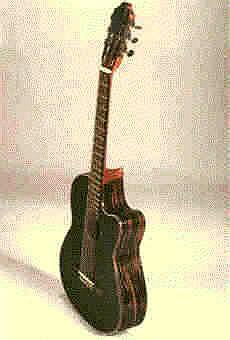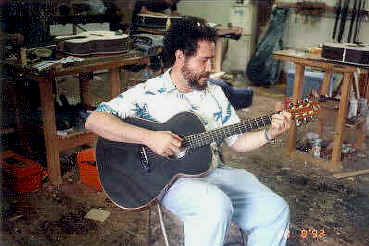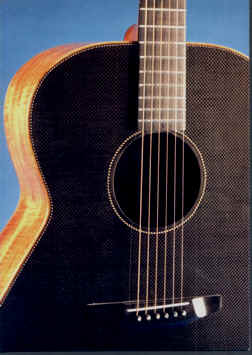 Graphite/
Macassar Ebony Cutaway Classic by William Cumpiano Graphite/
Macassar Ebony Cutaway Classic by William Cumpiano
William relaxes with his Koa/graphite steel-string

|
But thin sheets of softwoods crack easily when
exposed to ordinary climatic changes. They also "creep." Creep is a technical
term that describes the plastic deformation of a material after it has been under stress
for a long time. After years of use, many lightly-constructed guitar tops display
rippling, sinking, and bulging -- deformations that remain "set" even after the
string tension is released. A logical alternative to
spruce for sound boards are modern fiber-composite materials. They, too, are strong and
light. They are also more uniform, an advantage that simplifies production processes. A
shiny, jet-black carbon sound board was developed over a period of two and a half years by
Rich Janes, a product-development engineer with over fifteen years of experience in the
field of fiber composites; and guitarmaker William Cumpiano. Together, they developed a
multi-laminate fiber-composite material that closely mimics the an-isotropic (non-uniform)
stiffness characteristics of spruce.
The material is seen by its developers as "a modern
alternative to the traditional softwood sound boards" which can be used on all kinds
of plucked stringed instruments. Cumpiano said, "we designed the material as an
analog to Spruce wood--which, by the way, is also made up of carbon-based fiber. The trick
was to design the lay-up of the sheets to mimic the peculiarities of the natural material,
so that its sound would be similar.
The material is composed of many laminations of
resin-impregnated carbon fiber "skins" which are laid up in a special way. The
lay-up is then heat-pressed to a 1/16 to 1/32-inch thickness. The process yields an
enormously strong, stable and light material that will never creep or crack. The material
also displays superior acoustic characteristics: when held up and rapped with the
knuckles, the material rings like a bell! The material's outer face displays a beautiful,
woven layer of carbon fiber a under polished lacquer" Indeed, a small number
of other instrument manufacturers have developed their own composite soundboards, notably
the Ovation and Decker/ Windsong guitar companies. Their own patented processes, however,
are significantly different from the Janes and Cumpiano patent, and result in sound boards
that are not as acoustically efficient or as attractive.
Although industry has been slow on the uptake, William is
currently producing extraordinary sounding steel-string and classic guitars, in small
quantities, using his patented "Fibracustic" soundboards.
Find out more about
how to obtain and evaluate these instruments here. |

 Graphite/
Macassar Ebony Cutaway Classic by William Cumpiano
Graphite/
Macassar Ebony Cutaway Classic by William Cumpiano